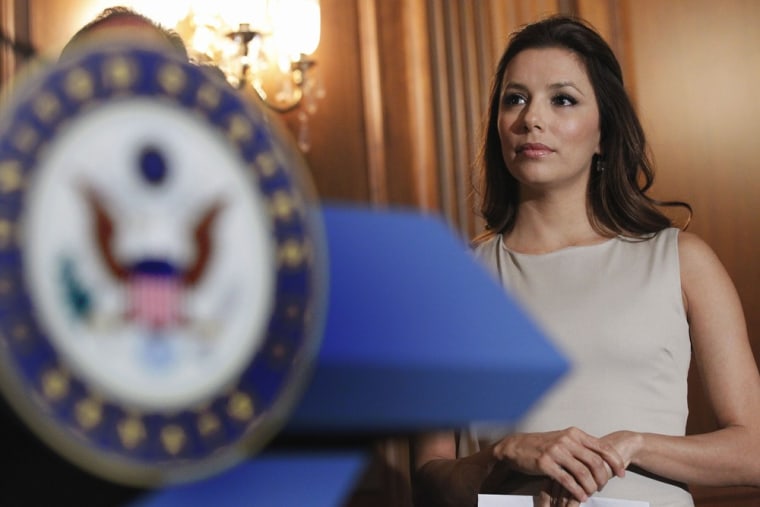A presidential commission called Thursday for the creation of a national museum devoted to American Latino history and culture next to the Capitol as part of the Smithsonian Institution, drawing strong endorsements from the top ranks of government.
The commission, which included Eva Longoria from TV's "Desperate Housewives" and producer Emilio Estefan, spent a year hearing comments from more than 100,000 people on the need for such a museum. They returned with a lengthy report that lays out the contributions of Latinos and said a museum would represent Latinos where their heritage has been absent at the Smithsonian.
"Being a ninth-generation American, growing up in south Texas on land that was given to us from the Spanish around the 1600s, I'm living proof that Latinos have been in America for a very long time," Longoria said at the Capitol.
The nation's increasing diversity and dramatic growth of the Latino population makes the Smithsonian American Latino Museum an urgent priority, commission chairman Henry R. Munoz III said.
"More than any other place in this country, the National Mall is the space that tells the story of America, and today that story isn't complete," he said. "We ask not to be treated differently than any other museum that has been created in partnership with the Smithsonian."
Interior Secretary Ken Salazar and Labor Secretary Hilda Solis endorsed the commission's recommendations.
Historical perspective
In an interview with The Associated Press, Salazar said such a building on the Capitol's grounds would be in keeping with the National Park Service's plan for the National Mall, which calls for overhauling the nearby reflecting pool as a civic square. Many contributions of Latinos, dating back to before the nation's founding, have never been recognized, he said.
"My own view is America's strength in the future is dependent upon America being inclusive of all of its people," Salazar said. "In the United States today, we have about 50 million-plus Americans who are of Latino descent."
A 1994 Smithsonian report entitled "Willful Neglect" found Hispanics were the only major contributor to American civilization not permanently recognized at the museum complex. That led to creation of the Smithsonian Latino Center to devise new programs.
A Latino museum would join the Smithsonian's National Museum of the American Indian and its planned National Museum of African American History and Culture, slated to open in four years. There has been some hesitance in Congress to add more ethnic museums for fear that they appeal to segregated audiences.
The commission tried to head off such arguments from the start.
"This is not a museum for Latinos. This is a museum that more fully describes what the American story is," Munoz said. "The historical myth of the United States begins with 1776 and the Mayflower, totally ignoring the fact that we were here well before then and have been contributors to the development of this country in every single way."
Democratic California Rep. Xavier Becerra, who drafted legislation to form the museum commission, said he hasn't heard any direct opposition in Congress to creating the museum, though all budget matters will draw attention. It's an opportunity to "rectify what the Smithsonian will admit was a wrong," he said.
Becerra, who serves on the Smithsonian Board of Regents, said the board will want to make sure the museum complex will have the resources to handle any new responsibilities and create a high-quality space.
Republican California Rep. Devin Nunes, who is co-chair of the Congressional Hispanic Conference, would be more inclined to support a museum that's inclusive of all U.S. immigrants, spokesman Andrew House said. Nunes isn't opposed to a Latino museum but doesn't think it should be funded by taxpayers, due to federal deficits.
Munoz said he envisions a lively, interactive space with performances, food from various Latino traditions and perhaps a plaza that allows programs to spill out onto the Capitol grounds.
'The time is now'
The report lays out a case for retracing 500 years of Latino history in Mexico and the present-day United States. It notes Spanish explorers were first to land in Florida decades before English settlers founded Jamestown, and early expeditions led to the founding of San Francisco and Santa Fe, N.M. It details Latinos' contributions to the military, the economy and the arts.
At the same time, many groups want to add museums on the National Mall, including efforts to recognize the histories of women, gays and immigration.
"The history of all peoples has got to be told across America," Salazar said. "We can't deal with the whole world right now, but I think the time is now to do something like this."
Visitors at the National Museum of American History on Thursday had a variety of views.
"We're so multicultural now. You live around it, why not learn about it?" said Jennifer Frisch, a fifth-grade teacher who brought her class from Henrico County, Va.
Bob Rivet of San Jose, Calif., was visiting the museum with his wife, Anna. They said it might be better to have one museum devoted to various cultures but that a precedent was set with the American Indian museum, which they enjoyed visiting.
"It's almost like unfortunate in a way that they're all separate in a way," Bob Rivet said.
Federal budget constraints could be the biggest hurdle. The commission calls for building a $600 million museum with Congress providing half the funds and private donations covering the remainder. It's the same model as the African American museum project.
Salazar, one of the highest ranking Hispanics in government, pledged to help raise millions of dollars to privately fund the construction. He said organizers may need to raise more than half the funds if the federal budget is a roadblock.
